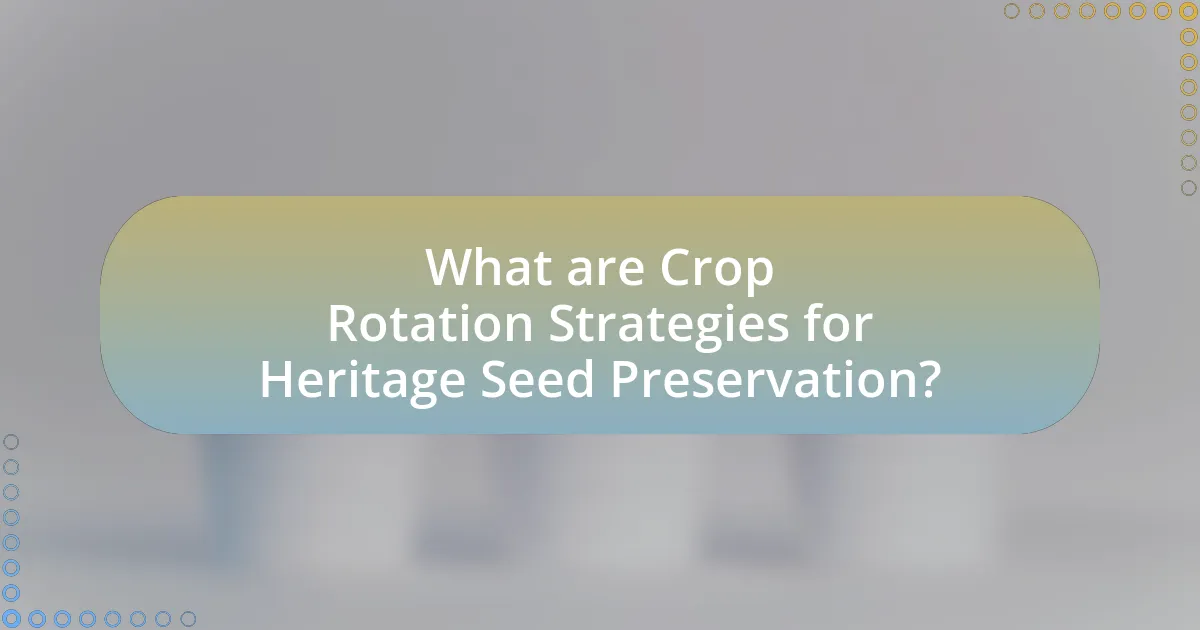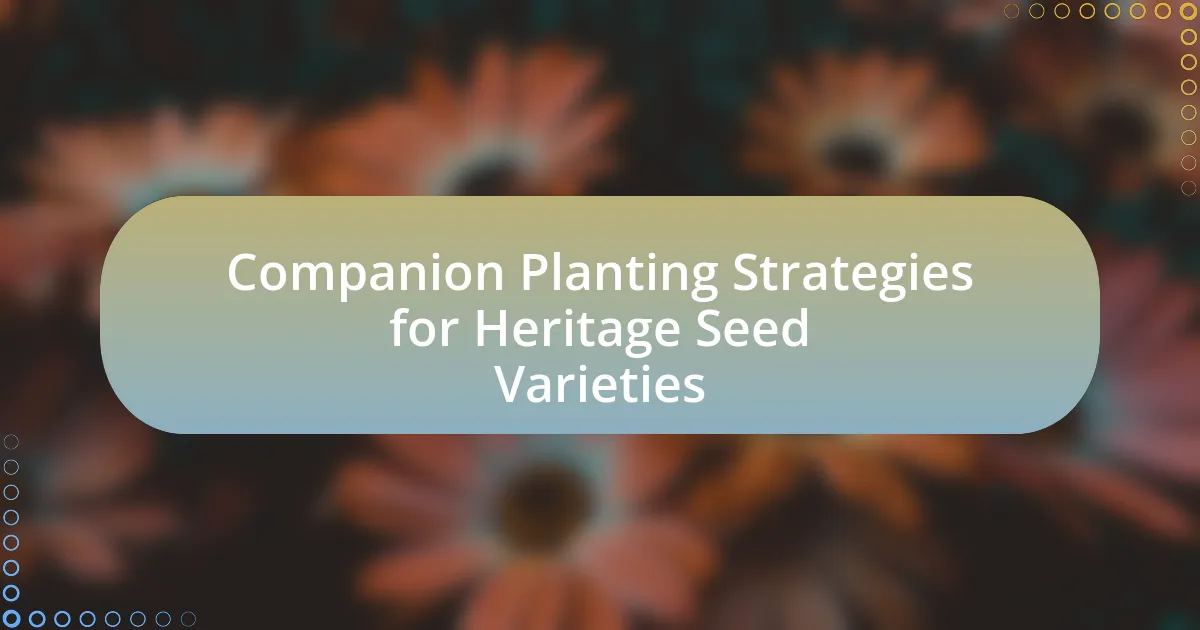Crop rotation strategies for heritage seed preservation involve the systematic alternation of different crops to enhance soil health and genetic diversity. These strategies are essential for preventing soil depletion, managing pests and diseases, and improving the resilience of heritage seeds. The article explores the significance of heritage seeds in agriculture, the principles of effective crop rotation, and the economic implications of adopting these practices. It also addresses challenges faced by farmers in implementing crop rotation and provides best practices for monitoring and evaluating the effectiveness of their plans. Additionally, resources available for farmers interested in heritage seed preservation through crop rotation are highlighted.

What are Crop Rotation Strategies for Heritage Seed Preservation?
Crop rotation strategies for heritage seed preservation involve alternating different crops in a specific sequence to maintain soil health and genetic diversity. These strategies help prevent soil depletion, reduce pest and disease cycles, and enhance the resilience of heritage seeds. For instance, rotating legumes with grains can improve nitrogen levels in the soil, benefiting subsequent crops. Research indicates that diverse crop rotations can lead to higher yields and better pest management, which is crucial for preserving the unique traits of heritage seeds.
How do crop rotation strategies contribute to heritage seed preservation?
Crop rotation strategies contribute to heritage seed preservation by enhancing genetic diversity and reducing pest and disease pressures. By alternating different crops in a specific sequence, farmers can maintain a healthier soil ecosystem, which supports the growth of diverse plant varieties. This practice helps to prevent the depletion of specific nutrients and minimizes the risk of crop failure due to pests or diseases that target a single crop type. Research indicates that diverse cropping systems can lead to increased resilience in heritage seed varieties, ensuring their survival and continued cultivation. For example, studies have shown that rotating legumes with grains can improve soil fertility and promote the growth of heritage varieties, thereby preserving their genetic traits for future generations.
What is the significance of heritage seeds in agriculture?
Heritage seeds are significant in agriculture because they preserve genetic diversity and promote sustainable farming practices. These seeds, often heirloom varieties, have been cultivated over generations, ensuring resilience to pests and diseases while adapting to local climates. Research indicates that heritage seeds can yield crops with better flavor and nutritional value compared to modern hybrids. Furthermore, they contribute to biodiversity, which is crucial for ecosystem stability and food security, as highlighted by the Food and Agriculture Organization, which states that over 75% of crop diversity has been lost since the 1900s. This loss threatens agricultural sustainability, making the preservation of heritage seeds essential for future food systems.
How does crop rotation enhance soil health for heritage seeds?
Crop rotation enhances soil health for heritage seeds by improving soil structure, increasing nutrient availability, and reducing pest and disease pressure. This agricultural practice involves alternating different crops in a specific sequence, which helps to break pest and disease cycles that can affect heritage seeds. For instance, rotating legumes with cereals can enhance nitrogen levels in the soil, benefiting subsequent crops. Research indicates that diverse crop rotations can lead to a 20-30% increase in soil organic matter, which is crucial for maintaining soil fertility and structure. Additionally, crop rotation promotes a more balanced microbial ecosystem in the soil, further supporting the health of heritage seeds.
What are the key principles of effective crop rotation?
The key principles of effective crop rotation include diversifying crops, timing plantings, and managing soil health. Diversifying crops helps break pest and disease cycles, as different plants attract different pests and have varying nutrient needs. Timing plantings ensures that crops are rotated in a way that maximizes soil nutrient use and minimizes competition. Managing soil health involves alternating deep-rooted and shallow-rooted plants to improve soil structure and fertility. Research indicates that these practices can enhance biodiversity and increase yields, supporting sustainable agriculture.
How does diversity in crops affect pest and disease management?
Diversity in crops significantly enhances pest and disease management by disrupting the life cycles of pests and pathogens. When multiple crop species are grown together or in rotation, it creates a less favorable environment for specific pests and diseases that thrive on monocultures. Research indicates that polyculture systems can reduce pest populations by up to 50% compared to monoculture systems, as seen in studies conducted by the University of California, which found that diverse cropping systems lead to increased natural pest control through the presence of beneficial insects. Additionally, crop diversity can improve soil health and resilience, further reducing the likelihood of disease outbreaks.
What role does timing play in crop rotation for heritage seeds?
Timing is crucial in crop rotation for heritage seeds as it directly influences plant health, soil fertility, and pest management. Proper timing ensures that crops are planted and harvested at optimal growth stages, which maximizes yield and preserves the genetic integrity of heritage seeds. For instance, rotating crops based on seasonal growth patterns can prevent soil depletion and reduce the risk of disease, as different plants have varying nutrient requirements and pest vulnerabilities. Research indicates that timely crop rotation can enhance biodiversity and improve soil structure, which are essential for maintaining the viability of heritage seeds over generations.
What challenges are associated with implementing crop rotation strategies?
Implementing crop rotation strategies faces several challenges, including the need for careful planning and knowledge of crop compatibility. Farmers must understand the specific nutrient requirements and pest resistance of different crops to create effective rotations. Additionally, the transition from conventional farming practices to crop rotation can require significant changes in equipment and labor management. Research indicates that farmers may also experience short-term yield reductions as they adapt to new systems, which can deter adoption. Furthermore, market demand for specific crops can limit rotation options, making it difficult to implement diverse planting schedules.
How can farmers overcome resistance to change in traditional farming practices?
Farmers can overcome resistance to change in traditional farming practices by implementing education and demonstration programs that showcase the benefits of new methods. Research indicates that when farmers observe successful outcomes from innovative practices, such as improved yields or soil health, they are more likely to adopt these changes. For instance, a study published in the Journal of Agricultural Education and Extension found that participatory workshops significantly increased the adoption rates of sustainable practices among farmers. By providing hands-on experiences and evidence of success, farmers can effectively address skepticism and encourage the transition to modern agricultural techniques.
What are the economic implications of adopting crop rotation for heritage seeds?
Adopting crop rotation for heritage seeds can lead to increased economic sustainability for farmers. This practice enhances soil health, which can result in higher yields and reduced input costs over time. For instance, studies have shown that crop rotation can improve nutrient availability and pest management, leading to a decrease in the need for chemical fertilizers and pesticides. Additionally, heritage seeds often have unique traits that can be better expressed through diverse planting strategies, potentially allowing farmers to access niche markets and premium prices. Research indicates that farms employing crop rotation can experience a 10-20% increase in profitability compared to those that do not rotate crops, demonstrating the economic benefits of this agricultural strategy.
How can crop rotation strategies be tailored for specific heritage seed varieties?
Crop rotation strategies can be tailored for specific heritage seed varieties by considering the unique growth requirements and pest resistance of each variety. For instance, certain heritage varieties may thrive better in specific soil types or climates, necessitating a rotation plan that aligns with these conditions. Research indicates that rotating crops with complementary nutrient needs can enhance soil health and yield; for example, legumes can fix nitrogen in the soil, benefiting subsequent crops like heritage grains. Additionally, implementing a rotation that includes cover crops can suppress weeds and pests that target specific heritage varieties, thereby reducing the need for chemical interventions. This approach not only preserves the genetic diversity of heritage seeds but also promotes sustainable agricultural practices.
What factors should be considered when selecting companion crops?
When selecting companion crops, factors such as compatibility, growth habits, nutrient requirements, pest management, and disease resistance must be considered. Compatibility ensures that the crops can coexist without competing for resources, while growth habits determine how plants will interact in terms of space and light. Nutrient requirements are crucial to avoid depleting soil nutrients, and effective pest management can be achieved by choosing crops that deter pests or attract beneficial insects. Additionally, selecting crops with disease resistance can minimize the risk of spreading pathogens. Research indicates that these factors significantly influence crop yield and health, supporting sustainable agricultural practices.
How does climate influence crop rotation decisions for heritage seeds?
Climate significantly influences crop rotation decisions for heritage seeds by determining the suitability of specific crops for cultivation in a given region. Factors such as temperature, precipitation patterns, and seasonal variations dictate which heritage seeds can thrive, thereby guiding farmers in selecting appropriate crop rotations. For instance, in regions with a shorter growing season, farmers may prioritize heritage varieties that mature quickly, while in areas with ample rainfall, they might opt for crops that require more moisture. Historical data shows that traditional farming practices have adapted to local climate conditions, with successful heritage seed varieties often being those that have co-evolved with the local environment, ensuring resilience and sustainability in crop production.
What are the best practices for successful crop rotation in heritage seed preservation?
The best practices for successful crop rotation in heritage seed preservation include selecting diverse crops, maintaining soil health, and timing rotations effectively. Diverse crops help prevent pest and disease buildup, which is crucial for preserving the genetic integrity of heritage seeds. Maintaining soil health through practices such as cover cropping and organic amendments enhances nutrient availability and soil structure, supporting the growth of heritage varieties. Effective timing of rotations, based on crop life cycles and seasonal conditions, ensures optimal growth conditions and minimizes competition for resources. These practices are supported by research indicating that diverse cropping systems can increase resilience and yield stability, which is essential for the sustainability of heritage seed varieties.
How can farmers monitor and evaluate the effectiveness of their crop rotation plans?
Farmers can monitor and evaluate the effectiveness of their crop rotation plans by tracking key performance indicators such as soil health, crop yield, pest and disease incidence, and nutrient levels. Regular soil testing provides data on nutrient availability and microbial activity, which are critical for assessing soil health. Crop yield data can be collected at harvest to compare the productivity of different rotation sequences. Additionally, farmers can observe pest and disease patterns to determine if crop rotation is effectively disrupting pest life cycles. Research indicates that diverse crop rotations can reduce pest populations by up to 50%, demonstrating their effectiveness in managing agricultural ecosystems. By systematically collecting and analyzing this data, farmers can make informed adjustments to their crop rotation strategies to enhance sustainability and productivity.
What resources are available for farmers interested in heritage seed preservation through crop rotation?
Farmers interested in heritage seed preservation through crop rotation can access various resources, including agricultural extension services, seed banks, and online platforms dedicated to sustainable agriculture. Agricultural extension services provide localized support and education on crop rotation practices that enhance soil health and biodiversity, which are crucial for preserving heritage seeds. Seed banks, such as the Seed Savers Exchange, offer a repository of heritage seeds and guidance on their cultivation and rotation. Additionally, online platforms like the Organic Seed Alliance provide research, articles, and community forums focused on heritage seed preservation and crop rotation strategies, facilitating knowledge sharing among farmers.





